
Submitted by Administrator on Wed, 12/04/2017 - 15:23
Conservation is often about stemming the tide of adverse impacts caused by burgeoning humanity. But one conservation intervention is emphatically about generating improvement. If vertebrates, such as goats or rats, that have been introduced to islands can be removed, there is the prospect of restored vegetation, larger seabird populations and much more. Further, these benefits should persist in perpetuity, provided sensible quarantine is observed to ensure the nasty vertebrates do not return.
The worldwide total of successful eradication projects now exceeds 1000. Their benefits to seabirds in terms of improved breeding success have been documented. What has not been shown is whether the improvement in breeding success actually leads to enhanced seabird numbers. Yet the public and private funders of such projects are often providing money precisely in the hope that their dollars will allow seabirds to flourish.
Drawing upon very scattered data from across the world, a team led by Michael Brooke of the Department of Zoology, assembled population growth rates of 181 seabird populations of 69 species in the aftermath of successful eradication projects. After successful eradication, the most likely population growth rate was about 10 percent per annum. Populations with positive growth (151) greatly outnumbered those in decline (23), while seven exhibited no change.
An unexpected finding of the study, recently published in Animal Conservation, was that population growth was faster at newly-established colonies than at those already present, possibly because, if a new colony establishes, that indicates regional conditions favour seabirds.
Also unexpected was the finding that, in the first few years after eradication, population growth was faster than subsequently. This was a surprise because it might be anticipated that several years, the period needed for seabirds to reach maturity, would elapse before improved breeding success could contribute to population growth. That this did not happen suggests immigration drove the population increase in the early years. In other words, seabirds were apparently smart enough to spot and immigrate into the newly-created safe haven.
“Although the key result of our study confirms expectation, that eradication projects benefit seabirds, it is good to be able to demonstrate the fact, especially as funders providing millions of dollars very reasonably want evidence that their money is well spent,” says Brooke.
Seabird population changes following mammal eradications on islands. Animal Conservation
